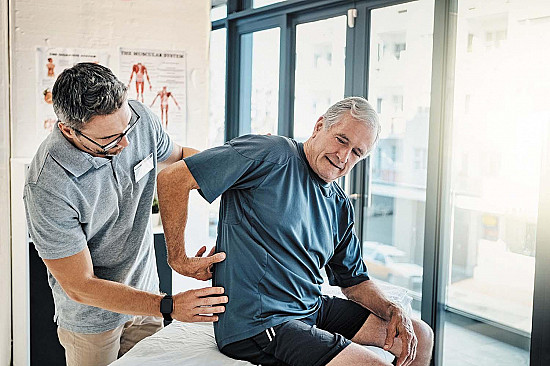
5 timeless habits for better health

What are the symptoms of prostate cancer?

Is your breakfast cereal healthy?

When pain signals an emergency: Symptoms you should never ignore

Does exercise give you energy?

Acupuncture for pain relief: How it works and what to expect

How to avoid jet lag: Tips for staying alert when you travel

Biofeedback therapy: How it works and how it can help relieve pain

Best vitamins and minerals for energy

Should you take probiotics with antibiotics?
Avoid workout injuries
Follow safe exercise guidelines today, so you can return to the gym tomorrow.
 You might be focused on outcomes when you exercise: stronger muscles, weight loss, or other aspects of better health and wellness. But if you don't focus on the exercise, and what it takes to do it safely, you may set yourself up for workout injuries.
You might be focused on outcomes when you exercise: stronger muscles, weight loss, or other aspects of better health and wellness. But if you don't focus on the exercise, and what it takes to do it safely, you may set yourself up for workout injuries.
Start strong
Safe exercise requires planning and careful execution. Start by finding the best exercise for your ability. For example, if you have joint pain, you can avoid workout injuries by choosing exercise that relieves joint pressure, such as swimming or cycling. If you have balance problems, a supervised exercise program with a personal trainer might be a safer bet. Discuss the options with your doctor, a personal trainer, or a friend; and get the okay from your doctor before starting a program, especially if you have heart or lung disease.
Getting the right equipment also helps ensure safe exercise. If using hand weights, start with a level that matches your current ability. And choose clothes and shoes designed for your type of exercise. For example, wear reflective clothing if you're going to walk, run, or cycle outside, so you'll be visible to drivers.
Basic rules for safe exercise
While you're exercising, avoid workout injuries by following some simple guidelines. Make sure that you:
- Start with a warm up. As reported in the Harvard Special Health Report Workout Workbook, warming up your body pumps nutrient-rich, oxygenated blood to your muscles as it speeds up your heart rate and breathing. Getting blood to the muscles helps make them more amenable to change, which will help you avoid workout injuries. A simple warm up can be walking in place while gently swinging your arms.
- Learn the correct way to do your exercises. Don't sacrifice good form and posture for the sake of finishing a set or routine.
- Boost your activity level gradually. Unless you already exercise frequently and vigorously, plan to work your way up to more complex routines.
- Pay attention to your body. Don't exercise when you're sick or tired from overtraining. Fatigue may increase your risk of workout injuries. Note that your joints should never hurt as a result of exercise. If they do, stop the exercise you're doing or you'll risk workout injuries.
- Stay hydrated while exercising, especially when it's hot or humid. If you're working out especially hard and sweating for more than an hour, you may want to choose sports drinks that replace fluids plus essential electrolytes. Just remember that these beverages may have lots of calories, so go easy on them.
- Call your doctor or 911 if you experience notable dizziness or faintness, chest pain, or significant or persistent shortness of breath.
After you exercise
Cool down after a workout for five to 10 minutes. It won't prevent workout injuries, but it will help prevent muscle cramps and dizziness while slowing quick breathing and a fast-beating heart. An easy way to cool down is to walk around or gently march in place until you notice that your heart rate and breathing are slowing down.
In between workouts, make sure you pay attention to muscle soreness. Soreness that begins 12 to 24 hours after exercise is normal. But if you have persistent or intense muscle pain that starts during a workout or right afterward, or persists more than one to two weeks, call your doctor.
Also, avoid training too hard or too often. Either can cause workout injuries from overuse like stress fractures, stiff or sore joints and muscles, and inflamed tendons and ligaments.
If you go for weeks or months without exercising, drop back if necessary when you start again by shortening cardio workouts, doing cardio at a lower intensity, lifting lighter weights, choosing easier exercises, or doing fewer reps or sets. This will help keep you on a safe exercise program and avoid workout injuries, so you can keep exercising in the future.
– By Heidi Godman
Executive Editor, Harvard Health Letter
Disclaimer:
As a service to our readers, Harvard Health Publishing provides access to our library of archived content. Please note the date of last review or update on all articles.
No content on this site, regardless of date, should ever be used as a substitute for direct medical advice from your doctor or other qualified clinician.

5 timeless habits for better health

What are the symptoms of prostate cancer?

Is your breakfast cereal healthy?

When pain signals an emergency: Symptoms you should never ignore

Does exercise give you energy?

Acupuncture for pain relief: How it works and what to expect

How to avoid jet lag: Tips for staying alert when you travel

Biofeedback therapy: How it works and how it can help relieve pain

Best vitamins and minerals for energy

Should you take probiotics with antibiotics?
Free Healthbeat Signup
Get the latest in health news delivered to your inbox!
Sign Up




